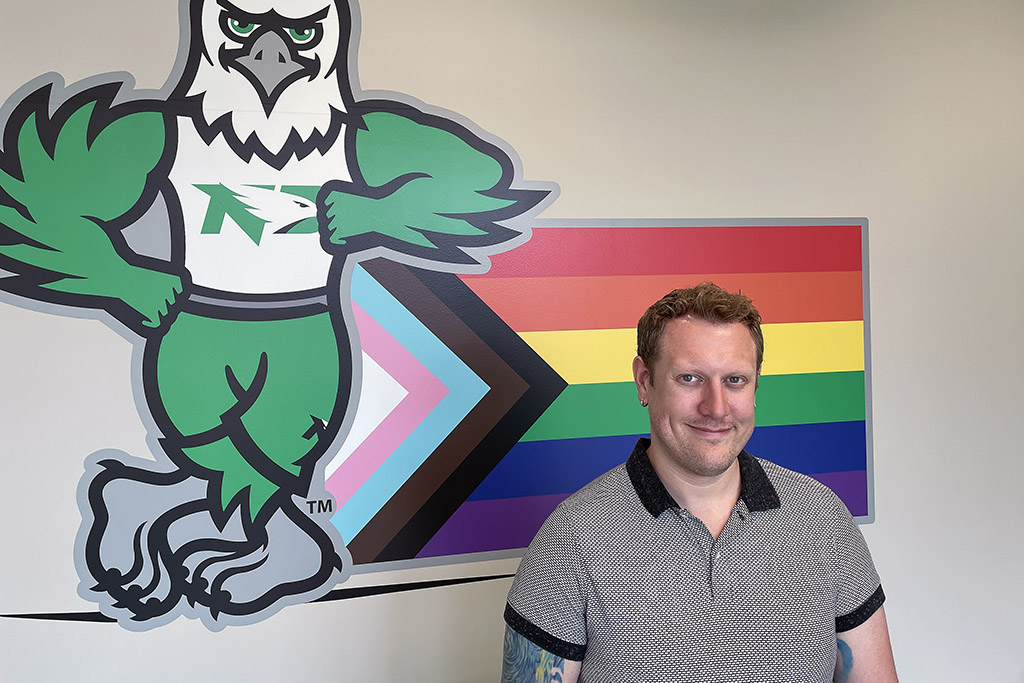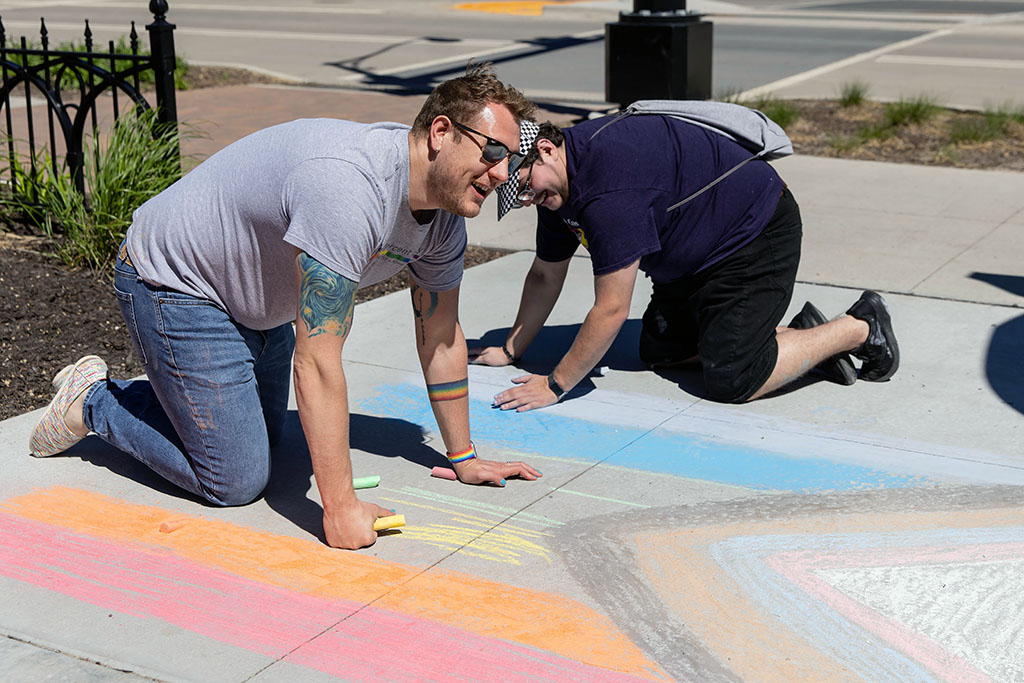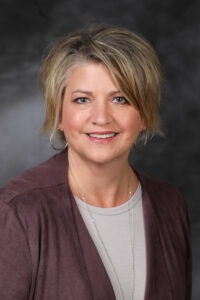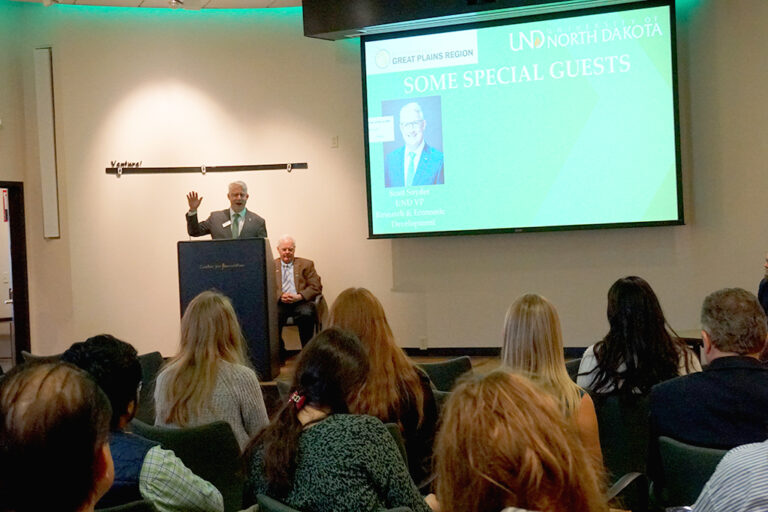Forty years of activism and support
Founded in 1982 under a different name, the Ten Percent Society was the first LGBTQ organization at UND — and in the state

UND Today sat down last week with Jeff Maliskey, the University’s assistant director of Student Diversity & Inclusion/LGBTQ Initiatives, to talk about the changes in the campus climate over the past four decades. This year marks the 40th anniversary of the origin of the Ten Percent Society, which was the first gay rights organization in North Dakota. Maliskey, who first joined UND in 2015 to take a job as a residence life coordinator, focused on that history in his doctoral dissertation. Here is more of what he had to say …
***
Q. Tell us about the Pride Center and your work at UND.
A. We support students from the moment they step on campus, all the way up to graduation and getting jobs. And there’s a long history of firsts here at UND.
UND was the first to have a recognized LGBTQ student group in the state of North Dakota. We’re the first of any college or university in the state to have a physical space, the Pride Center, dedicated for LGBTQ students. We’re the first to hire a full-time staff member whose job is to support LGBTQ+ students. And I’m pretty sure we’re the first to implement chosen names and pronouns in our campus onboarding. We’re probably the first to offer ally training as well.
UND is a flagship institution, and we’re the ones who are setting those trends for higher education. We’re also the first to hold a Pride Week during Pride Month, I believe.
My job is a little bit of everything, but a big piece of it is programming and creating educational opportunities for students. I do presentations in classes, work with student organizations and work with systems on campus. For instance, students being able to use Campus Connection to update their chosen name or pronouns. How are their names used across communication on campus? How are we creating more inclusive systems, processes and policies to support LGBTQ+ students across campus?
Programming and helping with student retention is another important piece.
Q. What do you love most about your job?
A. I came from the housing world, so I’ve always gravitated toward student affairs. I love being engaged and helping students. In college, I was a resident assistant, got involved in the halls and stayed very active. I got more involved in diversity and inclusion work later, and continued as a graduate student, and now I do it full time.
My work is really rewarding, and I can see the positive change we’re making on campus. It keeps me motivated.
Q. How has the Pride Center evolved? What is its impact?
A. The Pride Center used to be tucked away in a corner on the second floor of the Old Memorial Union. Today, we’re part of Diversity & Inclusion in the new Memorial Union. The Pride Center is not a standalone department, but it’s a comfortable space for students to hang out. They can hold events, have meetings, lounge, take a nap. It’s their space.
The Ten Percent Society and the students advocated for the Pride Center. They wanted a space where they could be authentic and be themselves, to come together as a community without judgment. They wanted to feel safe and have that sense of community and belonging.
We know students who feel connected do better academically, and that part really was missing for LGBTQ students before 2017. There was no space for them to have that sense of belonging. When we got the Pride Center, that was really great.

Q. Tell us about the history of the Ten Percent Society on campus.
A. There’s a lot of history just behind the name itself. The Ten Percent Society took that name in 1996, but the first organization at UND was founded in 1982 as the UND Gay Community. It was really revolutionary at the time because there was no LGBTQ organization in the state of North Dakota. UND was the first institution to recognize an LGBTQ group.
The name has changed a few times, and this year it changed to become the Queer & Trans Alliance to be more inclusive. We’re celebrating the 40th anniversary because it’s the same organization at its core.
The fact that the organization has endured more than 40 years is pretty significant. They’re still going, and there’s still a need. Even through the pandemic, we averaged about 20 members at our meetings on a regular basis. There is definitely a need.
Q. How many members are in the Queer & Trans Alliance? Can you talk about outreach and the impact of the organization?
A. We have between 18 and 20 members. National data tells us that roughly 17 percent of college students identify somewhere on the LGBTQ+ spectrum. If you apply that to UND’s roughly 14,000 students, that’s just over 2,000 students who identify. It’s not a huge number, but it’s pretty significant — it’s a big chunk of our student population.
We know the students are out there. They might not be involved specifically with the Queer & Trans Alliance. Maybe they’re finding other ways to get out and connect, or they’re just more intensely focused on their studies.
But the students promote the organization and let other students know there is a space here for them if they want to engage. They know there is support. They have an option, unlike the ’80s and ’90s, when other departments and organizations weren’t as accepting.
Now, we have more LGBTQ organizations on campus. We have the National Gay Pilots Association and Allies in Medicine. Pride Activism is a new group starting this fall. There are more and more ways to get involved, and that’s really been beneficial. Students are finding different support outlets.
And we’re starting to pick up the social connection. Students feel they’re getting the support structure and advocacy, and they just want to be students, to hang out and engage more in those ways. They’re starting to do more advocacy off campus, too, in the city and the state.

Q. What are some of the biggest changes you’ve seen?
A. I think the biggest thing is that the climate on campus has truly changed. You see people with rainbow flags and rainbow pins. It’s been from 2018 onward when we started to create some of the shifts where people are OK to engage in a conversation. The fact that we’re talking about these issues, that there are articles and videos, and that people sign up for ally training and engage in programs is significant.
President Armacost has been really engaged and supportive of our department. And just like the work we’re doing, when we have a leader who models that, I think it has a trickle-down effect. I see more people who want and are willing to create a better campus climate.
One telling example of how the climate really has changed was with our chalking event this week. When students did something similar in the 1990s, it was met with a lot of hate and discrimination. Back then, there was so much negative stigma attached to the gay community because of the AIDS crisis.
So, back in the 1990s, it was National Coming Out Day and students were out there chalking about statistics and just awareness and positive messages about LGBTQ people. And that night, more than 20 people were seen writing messages of hate over the chalk. So, that tells you about the campus climate at that time. There was an uproar of opposition, people were not happy about it, and it was in the headlines for weeks.
In contrast, our office and some members of the Queer & Trans Alliance did some chalking out in front of the Memorial Union this week. We didn’t have the same health education component, but this was loud and out in front of the new building. It was kind of taking a risk because there’s been a lot of “anti” legislation and social discrimination happening across the nation, so I didn’t know what to expect.
But we still had a pretty good turnout. People are talking, and you look out there and there’s no hate messages. Nobody has scratched it out or poured water over it to erase any of it.
It’s still vibrant, and you can look at it. That kind of shows you some of the shifts we’ve seen. There’s no hate messaging like there used to be. Now, some people might stop, look at it and not necessarily show support, but they’re not defacing it. That’s the difference today. A few people might see it and scoff, but then they move on with their lives, whereas in the ’90s, some people were absolutely furious, and the hatred was very present and outward.
Q. How do you think campus and the greater community are in a better place today?
A. I think we have more visibility than just five or six years ago, not just on campus, but also in the Greater Grand Forks community. We’re our own tiny, tightknit community, but we’re seeing more inclusion and acceptance, and that’s slowly starting to trickle into the community.
It’s a slow-moving process, but visibility has been a big shift. I think it’s changing. We have role models now. Students see the representation, the visibility on campus, they can come to UND and know there is a Pride Center. There are LGBTQ support services.
Q. What do you think the next five years will look like?
A. I think the big thing we’re seeing in higher education around LGBTQ support is a shift toward trans inclusion at the intersection of race and ethnicity. I think we need to watch what’s happening in the nation to see how that’s going to impact our students.
How are people seeing themselves reflected in the unique aspects of their race and identity? How are we making our students feel supported and seen and respected and validated? In the next five to 10 years, we need to look at how we make sure people are included and how our practices and policies reflect that.



